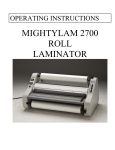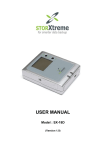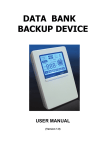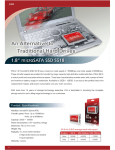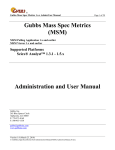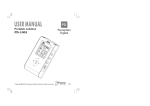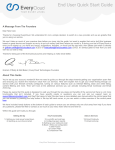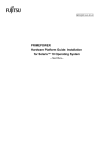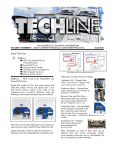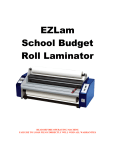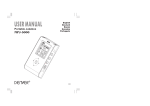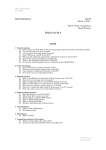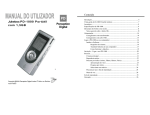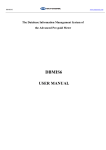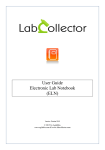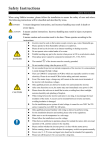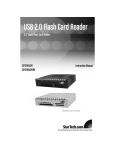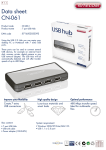Download PhotoBank USER MANUAL - kabel
Transcript
6.1 Operating System Supported 6.2 Verify windows has properly installed the device driver 6.3 Troubleshoot 6.4 Create Master Boot Record on the new hard disk. 6.5 Create Primary Partition Record on the new hard disk. PhotoBank USER MANUAL Table of Content Introduction 1. Product Part 1.1 Buttons 1.2 LED Indication 1.3 Connectors 2. Specification 2.1 Technical Specification 2.2 Electrical Specification 2.3 Product Specification 2.4 Minimum PC system requirement 2.5 Accessories Bundling 3. User Interface Description 3.1 Buttons Description 3.2 LED Description 3.3 Connectors Description 3.3.1 DC jack 3.3.2 Mini USB connector 3.3.3 SD/MMC/MS/XD Memory card slot 3.3.4 Compact Flash memory card slot 3.3.5 MiniSD/MS Duo/MS Pro Duo card slot 3.3.6 44 pins connector 4. Device operation 4.1 Copy (standalone) mode 4.2 USB mode 5. Windows 98SE / ME Installation 5.1 Operating System Supported 5.2 Install device driver on Windows 98SE / ME 5.3 Verify windows98SE has properly installed the device driver 5.4 Troubleshoot 5.5 Installing new hard disk on Win98SE / ME 5.6 Configure new hard disk in Win98SE / ME using Fdisk 5.7 Format new hard disk in Win98SE / ME 6. Windows –200x / XP Installation 1 2 2 2 3 3 3 3 4 4 5 5 5 6 6 6 7 7 8 9 9 10 11 11 11 12 13 13 13 15 17 i ii 17 17 18 18 19 Product Parts Eazy and EzDrive is the smallest & light integrated solution that provides external harddisk, card reader and memory card backup functions. As a portable external storage device, EzDrive is a perfect choice Light Card reader External hard disk This section give a briefly description on the part functionality. Refer User Interface Description section for detail description. 1.1 Buttons & switch Key Activation Press & Hold Press & Hold Select Press once Press for active mobile users providing a very light and optimal solution for personal information storage and transfer. Any PC with a USB port is enough for user to access documents, music, images, or any other data stored in the internal harddisk. In addition, EzDrive also acts as an all-in-one card reader supporting all major memory card types. Most importantly, EzDrive enhances the mobile users by enabling them to copy the content of a memory card into the internal harddisk without any PC or notebook required. User can backup the memory card content with a touch of the button or erase the memory card with the touch of the button. EzDrive allows the users to easily free up more expansive memory cards for re-use in the field. Copy Reset EzDrive supports TypeI, Type II Compact Flash (CF), MicroDrive, MagicStor, Secure Digital Card (SD), Multimedia Card (MMC), Memory Stick /DUO, Memory Stick PRO/DUO, Picture Card (xD), MiniSD, EzDrive hook to PC can be achieved using USB 2.0 High Speed (480Mbps) link. 1.2 LED Indication LED EzDrive comes equipped with an internal Li-polymer rechargeable battery. The battery can be charged either with an external DC adapter or via USB port when connect to the PC or notebook. 1.3 Connectors Type CON1 CON2 CON3 CON4 CON5 CON6 Specification 1 2 Operation Power On. Power Off. Select Copy or Delete mode Copy memory card to Hard disk in Copy mode Delete memory card in Delete mode Press Reset. Definition Card access Indication Memory card is accessed HDD access Hard disk is accessed Definition DC jack Mini USB connector Memory Card connector CF Card connector Memory Card connector HDD connector Purpose DC source +5V @ 1A Connect to PC or Notebook USB 1.0 or 2.0 port Memory Card slot (SD/MMC/MS/MS-PRO/xD) Compact Flash memory card or Microdrive slot Memory Card slot (MiniSD/MS Duo/MS Pro Duo 2.5 inch Hard disk CF to HDD SD to HDD MMC to HDD xD to HDD MS to HDD MS PRO to HDD Copy mode Data Transfer Rate USB Transfer Rate Operating OS Features USB compliance 3.5MBps 2.5MBps (2x) 3.4MBps (ultra speed) 1 MBps 2.3MBps 0.5MBps 3.5MBps This is a high speed USB device. Hard disk operates in UDMA mode 3. USB Transfer 24.5MBps Rate -Read USB Transfer 16.7MBps Rate -Write Windows 98SE, ME, XP, 2K(above), Mac V(above), Linux 2.4 (above) File System: FAT12, FAT16 or FAT32 Long Filename: Max 256 character, Support Unicode character Auto sleep: 30seconds (copy) Card reader cum external hard disk storage USB 2.0, 1.0 2.2 Electrical Specification Operating Condition DC output Lithium polymer rechargeable battery Operating Current 2.3 Product Specification Weight Size 0OC ~ 70OC + 5Volt @ 1.0Amper 3.7V 900mAh (above) 80mA (Idling) 100uA (shutdown) 800mA (depend on hard disk startup) 500mA (depend on hard disk read/write) 480mA (charge through USB) 820mA (charge through DC) 123mm*77mm*25mm 2.4 Minimum PC system requirement IBM Compatible PC PC 3 USB Port Pentium III (and above) 64MB USB1.0 or 2.0 HDD space 20MB OS Microsoft Platform (98SE/ME/XP/2000/2003) Mac OS V CPU RAM 2.1 Technical Specification 4 User Interface Description Accessories Bundling 3.1 Button and Switch Description Operation Key Activation Mode Press USB / Hold Standalone Power / Select USB cable Press Standalone Press USB / Standalone Copy / Installation CD Execute Reset Charger Description q Press and hold this button for a second to power-up the device. q Press and hold this button for few seconds, release the button to power down the device. q Press this button once to initiate copy in copy mode. The device copies all the content of the memory card to Hard disk. q Press this button once to initiate delete in delete mode. The device delete all the content in the memory card. q Press this button once to reset the device. Manual 3. 2 LED Description LED Indication 1 Card access Operation Mode USB Standalone 2 5 6 HDD access USB / Standalone Description q Inconsistent blinking indicates the memory card media is accessing. q Turn on indicates memory card is detected. q Consistent blinking indicates memory card is detected and prompt user for copy. q Inconsistent blinking indicates copy is in progress. q Inconsistent blinking indicates Hard disk is accessing This slot support any memory card such as Secure Digital card, Multimedia card, XD picture card, Memory Stick, Memory stick PRO. The device can be function as a memory card reader whenever user connects this device to the PC or notebook via USB connection. This device also support mini size memory card that come with the memory card adapter for example the Memory Stick DUO, the Memory stick PRO DUO and the miniSD. 3.3 Connectors Description 3.3.1 DC jack Connect the plug of the AC-DC Regulated wall adapter to this DC jack. Use the adapter that bundle together with this device. The inner ring of the shaft of the DC plug is positive power. Do not use wrong wall plug. The voltage output of the wall adapter must be between +5 Volts and +5.5 Volts. The current rating must be >= 1.0 Ampere. Do not use the DC wall plug with reverse polarity 3.3.4 Compact Flash memory card slot This slot supports Compact Flash Type I and II as well as Micro Drive card. This device support unlimited capacities size. 3.3.2 Mini USB connector Plug in the miniUSB cable into this connector and the other end of the cable to the PC or the notebook’s USB port or to any external USB hub. Use the miniUSB cable that bundle with this device. The device is compliance to USB 2.0 as well as USB1.0 specification. 3.3.5 MiniSD/MS Duo/Ms PRO Duo Flash memory card slot This slot support mini size memory card Memory Stick DUO, Memory stick PRO DUO and miniSD. This device support unlimited capacities size. Notebook connector view 3.3.3 SD/MMC/MS/XD Memory card slot 7 8 3.3.6 44 pins connector Slot the 2.5inch Hard disk drive into this connector as shown in the picture below. User needs to ensure that the 2.5-inch hard disk drive is not slot in the wrong direction if user needs to change the drive by his own. If user wants to connect 3.5inch Hard disk drive to this device, he need to use external PC power that has 12V & 5V supply and he need a 2.54mm to 2.00mm, 40-pin converter connector. This device support more than 128Gbytes of Hard disk capacities size. Device Operation 4.1 Copy (standalone) mode § Power up the device by pressing the ON button, notice the OK LED lights up. § User may insert any of the memory cards to the memory card slot. Notice the ACCESS LED blinks to prompt user to press COPY button to initiate copy. § During copying, the content of the memory card is coping to the hard disk. The ACCESS and HDD LED blink to indicate to user that both media are accessing and copy is in progress. A directory (e.g. FILE) is self-generated on the hard disk and the sub-folder is self generated. (i.e. CF000001, CF000002 … MS000001, MS000002.., SD00001…, MS00001…, XD00001… ) The CFxxxxxx sub-folder contains the content of the Compact Flash memory card, likewise to MSxxxxxx contains the content of the MS memory card. Remove harddisk jumper The harddisk Jumper must be configure to Device 0 setting. § If an error has occurred during copying, then user will notice the ERROR LED light up. User may validate the content of the memory card. User may ignore the empty folder selfgenerated in the hard disk if error has occurred. Error occur may be due to your memory card or Harddisk is not FAT or FAT32 formatted or not properly partition (refer the section on Installing new hard disk on Win98SE / ME / 2000 / WP for further information). The copy mode does not support memory cards or Harddisk that is NTFS formatted. Resolve error by re-partition& reformat the harddisk with FAT32 formatted or reformat the memory card to FAT32 formatted. Note: The memory card has its own proprietary formatted. You need to use the device such as camera or MP3 player to format your memory card. § If more than two memory cards present in the memory card slots, the CF is set as default to be copy to Hard disk. If you want the other memory card to be copy, eject the CF card from the CF memory card slot. § The device will automatically shutdown after idled for 30 seconds. § User can press & hold the ON button for few second to shutdown the device manually. 4.2 USB mode 9 10 § Connect the device to the PC via USB connection. 5.1 Operating System Supported Windows § Startup the PC as well as power up the device by pressing the ON button. Notice the OK LED lights up. § The windows OS will detect the device driver. Refer the “Window Installation” section if user has never installed the device in his PC before. § Notice 3 icons should appear on the “My Computer” screen. § Click on the Local disk icon or the Removable disk icon on the My Computer screen to access the information on the storage media. 98SE /ME Installation § Windows 98Second Edition (SE) or Windows Millennium Edition (ME) § The device driver is in the CD-ROM installation disk sub-folder “Win98SE driver”. 5.2 Install device driver on Windows 98 SE / ME § Connect the device to PC via USB connection. § Power up the PC as well as the device. Windows will detect “NEW HARDWARE FOUND” and prompt user to install device driver. q Load the CD-ROM installation disk. q Tick on “Search for best driver for your new device” and click Next. q Set the directory path “F:\Win98SE driver” (where F:\ is your CD-ROM drive) and click Next. q Follow through the online instruction. § Drag & drop any files from PC to device or vice versa. Notice the ACCESS or HDD LED blink to indicate that the file is downloading to the device or uploading from the device. Never remove the USB connection while file is uploading / downloading. § If the icon does not appear on the screen, user may verify the device has connected to the PC or verify the device drive has installed. (Refer “Windows Installation” section) § The device will automatically shutdown once user remove the USB cable from the device. § User can press & hold the ON button for few second to shutdown the device manually. 11 12 5.5 Installing new hard disk on Win98SE / ME § If a new harddisk is installed to this device, Windows 98SE or ME cannot recognize the new harddisk as local drive because new harddisk does not contain the Master Boot Record and Primary Partition Record information. o User can either use Windows 2000 or XP system to create harddisk Master Boot Record & Primary Partition Record. o User can either use Window98SE /ME to configure the new harddisk as a Removable drive. Windows 98SE /ME will enumerate the harddisk drive as a Removable drive instead of Local drive. § Follow the step to configure the New Harddisk before format the harddisk. (Old data will be destroy) § After the device driver has completed installation, notice 3 icons appear on the “My Computer” screen. Refer the section on “Installing new hard disk on Win98SE / ME & configure new harddisk in Win98SE / ME” if user do not see your harddisk icon. § Drag & drop any files from PC to device or vice versa if installation is successful. 5.6 Configure new hard disk in Win98SE / ME using Fdisk q Click on the My Computer icon by rightclick on the mouse. q Select the Properties item. q Choose the Device Manager selection q Double click the Disk drives item. q And check the INSTEP EzII DRIVE0 is present. q You can only see two Removable drives on the My Computer screen. 5.3 Verify Win98SE/ ME has properly installed the device driver q Click on the My Computer icon by rightclick on the mouse. q Select the Properties item. q Choose the Device Manager selection q Double click the Disk drives item. q And check the three INSTEP EzII DRIVE have installed. q Double click the Universal serial bus q Controller item. q And check the USB 2.0 EZDRIVEii has installed. 5.4 Troubleshoot § Click on the My Computer icon by right-click on the mouse. § Select the Properties item. § Choose the Device Manager selection § Double click the others item and check the USB 2.0 EZDRIVEii is mark with an exclamation mark. § Click on the item mark with an exclamation mark and then click Remove, Refresh. § The windows will prompt for device drive again. 13 Check the INSTEP EzII DRIVE0 is present. 14 Click on the Start, Program, Accessories and select MS-DOS prompt item. Type FDISK in the MS-DOS Prompt dialog box. Enter the choice < 5 > to change current fixed disk drive You have set the current fixed disk drive to 2. Now, enter the choice < 1 > to create DOS partition or logical Dos Drive. 15 If you cannot get to this screen, you must reboot the computer and try again. Type < Y > to wish to enable large disk support. 1~3 will depend on the number of harddisk drives present in the computer. Since 20GB harddisk is using in this the example, enter the choice < 2 > to change the current fixed disk drive. Enter < Y > to create primary DOS partition on current fixed disk drive 2 Enter < Y > to wish to use the maximum available size for a primary DOS partition Press ESC after primary DOS is created. Press ESC to exit fdisk. You must Reboot the computer. 5.7 Format new hard disk in Win98SE / ME q You must reboot the computer after perform fdisk. Ensure the new harddisk is enumerated and OS will assign a letter to the new drive. q Reboot the computer again once the computer is successfully detect the new harddisk before format the harddisk. q Click on the new Local Disk (L:) icon by rightbutton of mouse. q Select the Format option. q Choose the Full selection q Notice the New harddisk is formatting. q Reboot the computer again to let the OS initialize the new formatted harddisk successfully. Next, enter the choice < 1 > to create primary DOS partition 16 6.1 Operating System Supported Windows – 200x/XP Installation § Windows 2K , Windows XP & Windows 2003 § Supported by Microsoft default driver. (Requires service pack from Microsoft Windows Update website) 6.2 Verify windows has properly installed the device driver § Connect the device to PC via USB connection. § Power up the PC as well as the device. Windows will detect “NEW HARDWARE FOUND” and the Operating System (OS) will automatically install the Mass Storage device driver. Window OS initialize the card reader as Removable drive and the hard disk as Local drive. q Click on the My Computer icon by rightclick on the mouse. q Select the Properties item. q Choose the Device Manager selection q Double click on the Disk Drives item q And check the three INSTEP EzII DRIVE have installed. q Double click on the Storage volumes item. q And check the Generic volume properly installed. q Double click on the Universal serial bus controller item. q And check the USB Mass Storage Device has installed. § After the device driver has completed installation, notice 3 icons appear on the “My Computer” screen. Refer the section on “Create Master Boot Record on the new hard disk & Create Primary Partition Record on the new hard disk” if user do not see the harddisk icon. § Drag & drop any files from PC to device or vice versa if installation is successful. 17 18 6.3 Troubleshoot § Click on the My Computer icon by right-click on the mouse. § Select the Properties item. § Choose the Device Manager selection § Double click the Universal serial bus controller and check the USB Mass Storage Device is mark with an exclamation mark. § Click on the item mark with an exclamation mark and then click Remove, Refresh. § The windows will prompt for device drive again. q After Hard disk has created Master Boot record (write signature), you need to create a primary partition on your new hard disk. q Click on the Disk1 Unallocated bar by right-click of the mouse. q Choose the Create Partition option, follow by Next. q Windows XP and Windows 2000 cannot support more than 32Gbytes for FAT32 file system. q Choose the Primary partition option and let system assign a drive letter. q Choose the FAT32 format, Default allocation unit size and follow through the on-screen instruction. q The new Hard disk is formatted and ready to be use 6.4 Create Master Boot Record on the new hard disk. q Login the PC as Administrator. q Click on the My Computer icon by rightclick on the mouse and choose the Manager item. q Or Click on the Control Panel icon and follow by Administrative tools q Click the Disk Management icon. q Click Next in the write signature prompt & Upgrade Disk wizard prompt. q Tick on Disk 1 option and follow through the instruction. q The new Hard disk will create a Master Boot Record on the new hard disk. q Proceed to create a new primary partition 6.5 Create Primary Partition Record on the new hard disk. 19 20











